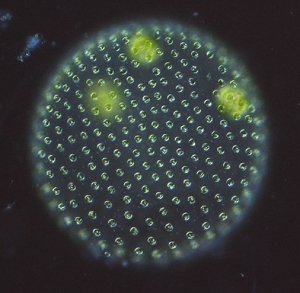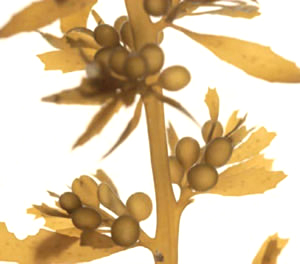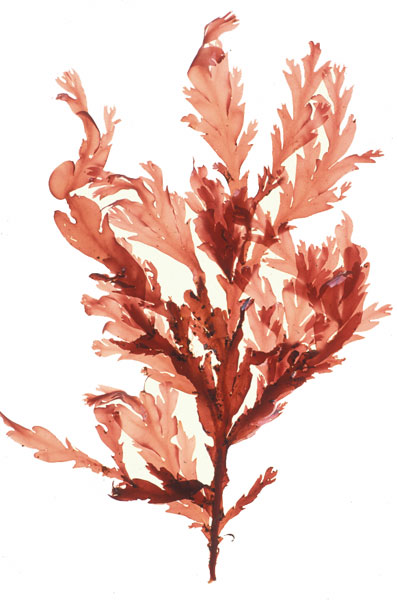What are algae?
Algae are pond scums, terrestrial algae, snow algae, seaweeds, freshwater and marine phytoplankton. The plant body is relatively undifferentiated, and there are no true roots and leaves.
Pronunciation: Algae ("al'jay" or "al'gay", both are used today) is the plural; Alga ("al'ga") is the singular, but here is no such thing as "algaes".
 Algae are very simple chlorophyll-containing organisms: some say that they are plants; other say that the are not, calling them protists or protoctists. According to the most recent phylogenetic studies, both are not quite correct. Some algae (most the greens and the reds) are indeed related to the land plants, and some flagellated algae are related to the protists, but there is no justification for the including all algae in any generic term other than "algae".
Algae are very simple chlorophyll-containing organisms: some say that they are plants; other say that the are not, calling them protists or protoctists. According to the most recent phylogenetic studies, both are not quite correct. Some algae (most the greens and the reds) are indeed related to the land plants, and some flagellated algae are related to the protists, but there is no justification for the including all algae in any generic term other than "algae".
We use the term "algae" very loosely, simply because coralling them is so very difficult. As conceived in the broadest sense, algae are oxygen-generating, photosynthetic organisms other than embryophyte land plants, fungi and lichens. Quite simply, what we call "algae" is an artificial and highly heterogeneous aggregation of organisms belonging to many different evolutionary lineages, and therefore highly diverse from a genetic point of view. This genetic diversity is reflected in the enormous biodiversity exhibited by algae in terms of morphological, ultrastructural, ecological, biochemical, and physiological traits.
Marine macroalgae, or seaweeds, are plant-like organisms that generally live
attached to rock or other hard substrata in coastal areas. They belong to three
different groups, empirically distinguished since the mid-nineteenth century by the Irish botanist William Henry Harvey (1811-1866) on the basis of thallus color: red algae (phylum Rhodophyta), brown algae (phylum Ochrophyta, class Phaeophyceae), and green algae (phylum Chlorophyta, classes Bryopsidophyceae, Chlorophyceae, Dasycladophyceae, Prasinophyceae, and Ulvophyceae). Distinguishing these three groups, however, involves more substantial differences than indicated by this simple designation. In addition to the pigmentation, they differ considerably in many ultrastructural and biochemical features including photosynthetic pigments, storage compounds, composition of cell walls, presence/absence of flagella, ultrastructure of mitosis, connections between adjacent cells, and the fine structure of the chloroplasts. In general, we can say that they are simple organisms composed of one cell, or grouped together in colonies, or as organisms with many cells, sometimes collaborating together as simple tissues.
 Spores. Most algae form some sort of spore, which is a cell - often motile - that serves to reproduce the organism with combining with another cell. Some are colonial and motile in the adult phase like Volvox (right, photograph © Karl Bruun).
Spores. Most algae form some sort of spore, which is a cell - often motile - that serves to reproduce the organism with combining with another cell. Some are colonial and motile in the adult phase like Volvox (right, photograph © Karl Bruun).
Sex? Algae also have sex, sometimes a very simple kind of sex where the algae themselves act as gametes, but also very complicated sex with egg and sperm-like cells. In all probability, an alga was the first organism to have something that we would recognise as sex, about 1.3 billion years ago (i.e. 1,300 million years ago). So sex was not somthing invented yesterday.
Internal transportation? Some of the larger kelps have translocation (transport of photosynthetic products) but most do not. They have no need for water-conducting tissues as they are, at leaset at some stage, surrounded by water. There are no seeds. Spores may be motile or non-motile, and this varies from phylum to phylum, e.g., the red and blue-green algae are non-flagellated and are essentially non-motile.
Algae of one kind or another have been around for over 2 billion years. We are still discovering new algae, sometimes whole groups of them at a time.
 Algae of other groups usually have two flagella (singular: flagellum). Reproduction may be isogamous, anisogamous, or oogamous. Female gametangia are not enclosed by a wall of sterile cells as in higher cryptogams. Mostly autotrophic (photosynthetic), pigments very variable and are the basis of classification; all have chlorophyll a; some have b, others c; all have accessory pigments of some kind e.g. phycocyanin (blueish), phycoerythrin (reddish), carotenes (yellow-brown), xanthophylls (brown, notably fucoxanthin found in brown algae).
Algae of other groups usually have two flagella (singular: flagellum). Reproduction may be isogamous, anisogamous, or oogamous. Female gametangia are not enclosed by a wall of sterile cells as in higher cryptogams. Mostly autotrophic (photosynthetic), pigments very variable and are the basis of classification; all have chlorophyll a; some have b, others c; all have accessory pigments of some kind e.g. phycocyanin (blueish), phycoerythrin (reddish), carotenes (yellow-brown), xanthophylls (brown, notably fucoxanthin found in brown algae).
 Some are heterotrophic (get energy from non-photosynthetic sources also). Great variation in size - unicellular and 3-10 µm (microns: a micron is one-thousanth of a millimeter) to giant kelps up to 70 meters long and growing at up to 50 cm per day. Found in mostly aquatic situations (need water to reproduce and, generally, to photosynthesise).
Some are heterotrophic (get energy from non-photosynthetic sources also). Great variation in size - unicellular and 3-10 µm (microns: a micron is one-thousanth of a millimeter) to giant kelps up to 70 meters long and growing at up to 50 cm per day. Found in mostly aquatic situations (need water to reproduce and, generally, to photosynthesise).
Where are algae found? Algae are found just about everywhere on earth: in the sea, in our rivers and lakes, on soils and walls, in animals and plants (as symbionts - partners collaborating together); on plants and animals; in fact just about everywhere where there is light with which to photosynthesise.
We currently know of over 48,000 species of algae: up-to-date figures and the numbers for each phylum and class are provided dynamically by AlgaeBase.
Back to index page
Last modified: October 11 2020





